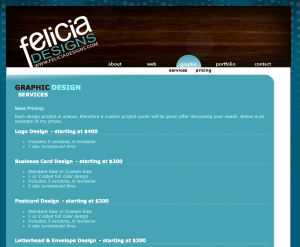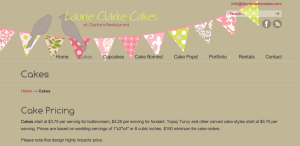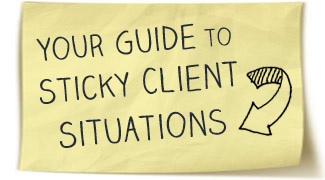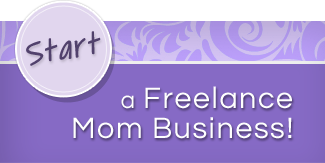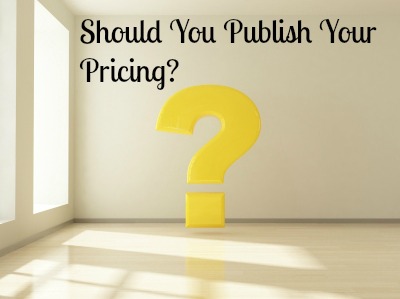
The debate over whether entrepreneurs should post pricing on their websites has been raging for years – and it can be hard for those just starting out to decide what to do.
Obviously, if your business is selling hand-embroidered tea cozies, self-help e-books or some other commodity, your product will have a set price that you can (and should) list. But if your business is service-based, or relies on custom orders, the question of posting your pricing online becomes trickier.
Consultants, freelancers, and any entrepreneur who relies on quoting rates all have great reasons to keep their pricing structure close to their chests – but there are a number of equally good reasons to spill the beans. Whichever you choose to do, this post will help you evaluate your options.
Why You SHOULD Publish Your Rates
1. It helps qualify clients before they call you.
Posting rates will weed out potential clients who can’t afford your services, or who might try to lowball your prices. If you’ve ever spent an hour on a phone call only to have a potential client balk at your quote, you can understand the appeal.
Felicia Designs, for example, is a design studio in Albuquerque, NM, who’s bucked the trend and posted rates on their website. Stating clearly that the price for a logo design starts at $400 will automatically weed out the type of clients who think a good rate is 10 logos designs for $50.
It’s easiest to use this strategy for one-time projects, or packages (say, a package of 5 one-hour consultations).
2. Potential customers are looking for your rates
Sure, your higher rates may scare off some potential clients, but the reality is that fewer people are picking up the phone these days. You may be expecting interested clients to call and inquire about your pricing, but on the flip side you may lose out on clients who are looking for information before making a decision.
3. It creates transparency
A main argument many entrepreneurs have against posting their rates is that their competitors might see it and take advantage. This could be true in some highly competitive fields, but in others that are more collaborative, being transparent about your pricing can help raise rates in your industry overall.
How?
- Those just getting into the business will get a better idea of going rates, and won’t undercut your pricing – and sell themselves short – by accident.
- Clients shopping around will get a better idea of what services are valued at.
- It helps take away some of the stigma about talking about money.
Much like transparency about salaries is a tool to help ensure that women get equal pay, so transparency among entrepreneurs about rates can be a great tool for the community.
Being open about the prices you charge helps add to the discussion of how valuable your services actually are – especially in an internet age where people charging rock-bottom prices can drag down the whole pricing structure for the rest of us.
Why You SHOULDN’T Publish Your Rates
Maybe you read the above section and thought there’s no way on earth you could give someone a ballpark estimate without talking to them first. Every project is different, every client is unique, and maybe a lot of your fee depends on getting a feel for things first.
1. You can’t quote without knowing the scope of the project.
Each project involves a different amount of work. One client’s idea of a website design may be five simple pages on a WordPress install – but another client may be envisioning a 50-page site with custom shopping carts and animation. Obviously, you’d charge two wildly different rates for the projects.
2. You don’t want to be held to a static rate.
Many entrepreneurs keep an “annoyance fee” in their back pocket for clients that seem like they’ll be more trouble than others.
If you’re a florist who does a lot of weddings, for example, you may have a base fee – but if you get the sense that a particular bride’s constant requests will take your time away from other clients, you might pad that fee to make up for knowing you’ll spend extra time on her order.
3. You don’t want your rates to scare off clients
One of the main arguments against posting your pricing is that you may scare off clients who don’t understand the value of what you do. They might balk, and you’ve lost a sale. If a customer has to call to ask pricing, you get a chance to overcome their price objections in person.
Tips For Publishing Your Pricing
If you’ve decided to go for it and post your rates, here are a few tips to make sure it works in your favor.
Give yourself some wiggle room.
Quote a range of prices, or like in the Felicia Design example above, list your starting rate for certain services. This gives you leeway to evaluate projects as they come up, and give each client a customized quote. Be sure you have all the details you need before giving a quote, of course!
Get specific
List out everything that’s included in a particular service, so there’s no confusion on either end. Here’s a great example from Laurie Clarke Cakes in Portland. Notice how incredibly detailed she is about what’s included – down to detailing the size of a serving.
Sell the value of your services in writing
You know how valuable your services are – that’s why you decided on that price! Now make sure potential clients know it, too. Use your website to help avoid sticker shock. Include testimonials and case studies that showcase your results, point out the ways you go above and beyond, and be sure to detail what sets you aside from your competitors.
Sales copywriting is a huge topic to cover, but the key is remembering to focus on how each detail of your services benefits your customers. If you’re a consultant, for example, do you provide a workbook with each consultation so that customers can get the most out of their sessions?
Let potential customers know what the concrete benefits to hiring you are, and they’ll be more likely to accept your pricing.
Do you post your rates? Why or why not? Let us know in the comments.
Further reading
Embrace the Controversial: Why You Should Publish Pricing on Your Website. Be sure to read through the comments for a great discussion on the pros and cons of posting your rates.
Freelancing: a Complete Guide to Setting and Negotiating Rates. Not sure what your rates should be? Check out this great post from Tom Ewer’s Leaving Work Behind.
A (Proven) Freelancer’s Guide to Growing Your Business – this is a guest post from Paul Jarvis on Noah Kagan’s OkDork site. Great info here.
Photo credit
